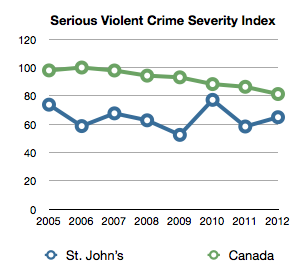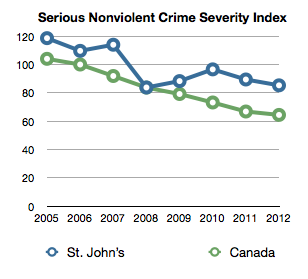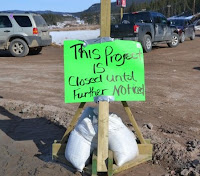In my column yesterday on crime rates, I noted that recent increases in the violent crime index were mainly caused by increased recording of minor crimes like uttering threats and common assault (meaning assault without a weapon and no bodily harm). As an experiment, I put together a couple modified crime indices that use only serious crimes. These indices use only crimes listed by Stats Can as having above average weight for severity and normalized so that 100 is the Canadian average in 2006. Here are the results.

Serious violent crime in Canada has fallen about 20 percent since 2006, which is very impressive progress. St. John's has held pretty steady and remains below the Canadian average.

Here are some tables ranking Canadian metropolitan areas in terms of these crime indices.
Serious Violent Crime Index
|
Winnipeg, Manitoba (9,10,47)
|
188.7
|
|
Saskatoon, Saskatchewan
|
145.9
|
|
Regina, Saskatchewan
|
128.1
|
|
Thunder Bay, Ontario
|
124.1
|
|
Vancouver, British Columbia (12,13,14,28)
|
105.8
|
|
Edmonton, Alberta
|
104.3
|
|
Halifax, Nova Scotia
|
99.8
|
|
MontrÈal, Quebec (38,50,53)
|
94.4
|
|
Toronto, Ontario (33)
|
94.2
|
|
Abbotsford-Mission, British Columbia (8,28)
|
81.4
|
|
Canada (50)
|
81.3
|
|
Kelowna, British Columbia (8,28)
|
77.6
|
|
Sudbury, Ontario
|
74.5
|
|
Peterborough, Ontario (8)
|
68.9
|
|
Windsor, Ontario
|
68.3
|
|
Calgary, Alberta
|
67.1
|
|
Hamilton, Ontario (33)
|
66.9
|
|
London, Ontario
|
65.9
|
|
Ottawa-Gatineau, Ontario part (6,52)
|
65.4
|
|
St. John's, Newfoundland and Labrador
|
64.9
|
|
Ottawa-Gatineau, Ontario/Quebec (6,52)
|
63.5
|
|
Kitchener-Cambridge-Waterloo, Ontario
|
60.9
|
|
Victoria, British Columbia (28)
|
59.6
|
|
Saguenay, Quebec (5)
|
57.8
|
|
Ottawa-Gatineau, Quebec part (6)
|
57.4
|
|
Brantford, Ontario (8)
|
56.6
|
|
St.Catharines-Niagara, Ontario
|
54.9
|
|
Moncton, New Brunswick (8)
|
52.5
|
|
QuÈbec, Quebec
|
43
|
|
Barrie, Ontario (8)
|
42.8
|
|
Sherbrooke, Quebec (32,37)
|
42.7
|
|
Kingston, Ontario (8)
|
40.9
|
|
Trois-RiviËres, Quebec
|
40.2
|
Serious Nonviolent Crimes Index
|
Kelowna, British Columbia (8,28)
|
99.8
|
|
Brantford, Ontario (8)
|
98.2
|
|
Regina, Saskatchewan
|
91.5
|
|
Saskatoon, Saskatchewan
|
88.8
|
|
Vancouver, British Columbia (12,13,14,28)
|
86.6
|
|
St. John's, Newfoundland and Labrador
|
85.3
|
|
Winnipeg, Manitoba (9,10,47)
|
74.9
|
|
Abbotsford-Mission, British Columbia (8,28)
|
74.9
|
|
London, Ontario
|
72.1
|
|
MontrÈal, Quebec (38,50,53)
|
71.5
|
|
Edmonton, Alberta
|
69.9
|
|
Sudbury, Ontario
|
67.7
|
|
Trois-RiviËres, Quebec
|
66
|
|
St.Catharines-Niagara, Ontario
|
66
|
|
Moncton, New Brunswick (8)
|
65.8
|
|
Canada (50)
|
64.4
|
|
Ottawa-Gatineau, Quebec part (6)
|
63.9
|
|
Thunder Bay, Ontario
|
62.4
|
|
Windsor, Ontario
|
62.2
|
|
Calgary, Alberta
|
60.3
|
|
Saguenay, Quebec (5)
|
57.9
|
|
Hamilton, Ontario (33)
|
57.1
|
|
Peterborough, Ontario (8)
|
55.3
|
|
Victoria, British Columbia (28)
|
55
|
|
Saint John, New Brunswick (4,47)
|
54.1
|
|
Sherbrooke, Quebec (32,37)
|
53.4
|
|
Halifax, Nova Scotia
|
52.5
|
|
Kitchener-Cambridge-Waterloo, Ontario
|
51
|
|
Ottawa-Gatineau, Ontario/Quebec (6,52)
|
49.6
|
|
Kingston, Ontario (8)
|
47.1
|
|
QuÈbec, Quebec
|
46.7
|
|
Barrie, Ontario (8)
|
46.1
|
|
Ottawa-Gatineau, Ontario part (6,52)
|
44.8
|
|
Guelph, Ontario (8)
|
41.4
|
|
Toronto, Ontario (33)
|
38.6
|

 You may be sick of hearing about the Muskrat by now. For the last year it has dominated the political discourse and is likely to continue to cast a shadow for some time (may as well resign yourself to that).
You may be sick of hearing about the Muskrat by now. For the last year it has dominated the political discourse and is likely to continue to cast a shadow for some time (may as well resign yourself to that).

